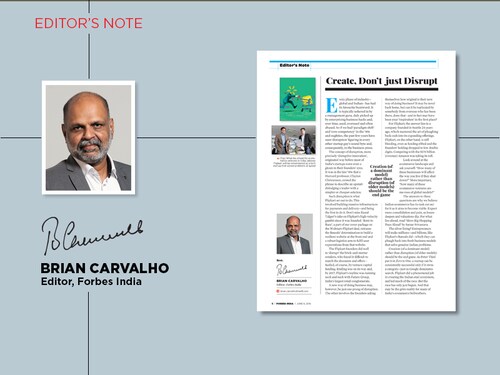Create, don't just disrupt
Creation (of a dominant model) rather than disruption (of older models) should be the end game


Every phase of industry—global and Indian—has had its favourite buzzword. It is typically ushered in by a management guru, duly picked up by enterprising business hacks and, over time, used, overused and often abused. So if we had ‘paradigm shift’ and ‘core competency’ in the ’90s and oughties, the past few years have seen ‘disruption’ figuring in every other startup guy’s sound byte and, consequently, in the business press.
The concept of disruption, more precisely ‘disruptive innovation’, originated way before most of India’s startups were even a gleam in their founders’ eyes. It was in the late ’90s that a Harvard professor, Clayton Christensen, coined the phrase to describe an upstart dislodging a leader with a simpler or cheaper solution.Such disruption is what Flipkart set out to do. This involved building massive infrastructure for payments and delivery—and being the first to do it. Don’t miss Kunal Talgeri’s take on Flipkart’s high-velocity gambit since it was founded. ‘Born to Race ’, a part of our cover package on the Walmart-Flipkart deal, retraces the Bansals’ determination to build a resilient website at the front end and a robust logistics arm to fulfil user expectations from that website.
The Flipkart founders did well to ‘disrupt’ the brick-and-mortar retailers, who found it difficult to match the discounts and offers—fuelled, of course, by venture capital funding. Etailing was on its way and, by 2017, Flipkart’s topline was running neck and neck with Future Group, India’s largest retail conglomerate.
A new way of doing business may, however, be just one prong of disruption. The other involves the founders asking themselves how original is their new way of doing business? It may be novel back home, but can it be replicated by somebody from overseas who has been there, done that—and in fact may have been your ‘inspiration’ in the first place?
For Flipkart, the answer lies in a company founded in Seattle 24 years ago, which mastered the art of ploughing back cash into its expanding offerings. Flipkart, on the other hand, is still bleeding, even as funding ebbed and the founders’ holding dropped to low double digits. Competing with the $178 billion (revenue) Amazon was taking its toll.
Look around at the ecommerce landscape and ask yourself: “How many of these businesses will affect the way you live if they shut down?” More important, “how many of these ecommerce ventures are me-toos of global models?”
The answers to these questions are why we believe Indian ecommerce has its task cut out for it as it aims to become viable. Expect more consolidation and pain, as losses deepen and valuations dip. For what lies ahead, read ‘More Big Shopping Days Ahead ’ by Samar Srivastava.
The silver lining? Entrepreneurs will make millions—and billions, like Flipkart’s Bansals did—which they can plough back into fresh business models that solve genuine Indian problems.
Creation (of a dominant model) rather than disruption (of older models) should be the end game. As Peter Thiel put it in Zero to One, a startup can be consistently successful only if it owns a category—just as Google dominates search. Flipkart did a phenomenal job in creating the Indian etail ecosystem, and led much of the race. But the race has only just begun. And that may be the grim reality for many of India’s ecommerce bellwethers.
Best,
Brian Carvalho
Editor, Forbes India
Email:Brian.Carvalho@nw18.com
Twitter id:@Brianc_Ed
First Published: May 24, 2018, 11:16
Subscribe Now
